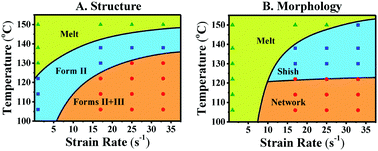Structural and morphological transitions in extension-induced crystallization of poly(1-butene) melt†
Abstract
Structural and morphological transitions of flow-induced crystallization (FIC) in poly(1-butene) (PB-1) melt have been studied by combining extensional rheology and in situ synchrotron radiation ultrafast wide- and small-angle X-ray scattering (WAXD/SAXS) measurements. Unexpectedly, metastable Form III is crystallized directly from the PB-1 melt by high-speed extension, which has a short lifetime of several tens of milliseconds and manifests the thermodynamic and kinetic competition among Form III, Form II and melt under flow. Relative crystallinity evolution of Form II after extension reveals a crystal melting dominated process within the observation time of 120 s even under high supercooling. This is opposite to the common case of FIC but supports the idea that flow alters the obtained crystal size and its thermodynamic stability. Additionally, a morphological transition from a flow-induced network to shish is observed by SAXS with increasing extension temperature from below to above the melting point of Form II. With above observations, we construct nonequilibrium structural and morphological diagrams of FIC in strain rate-temperature space, which may guide the industrial processing of the PB-1 material.



 Please wait while we load your content...
Please wait while we load your content...